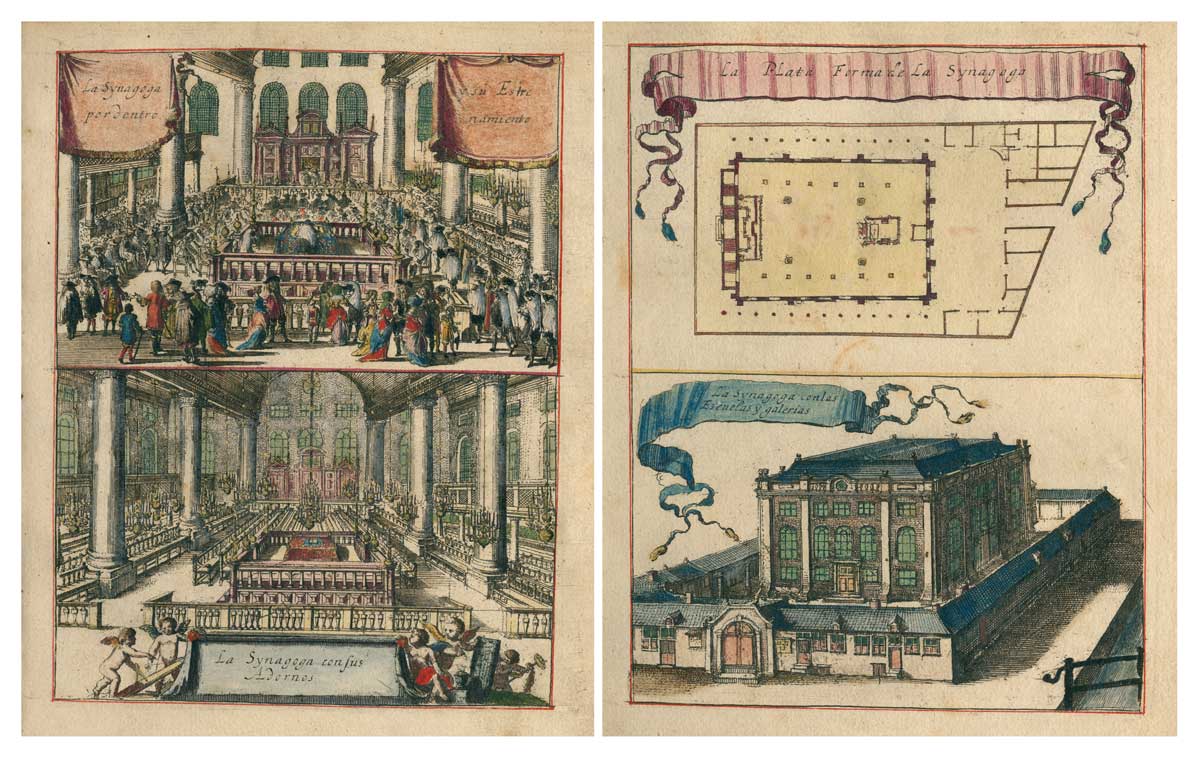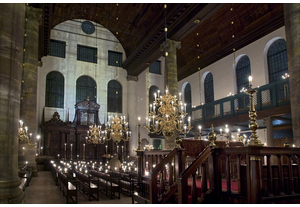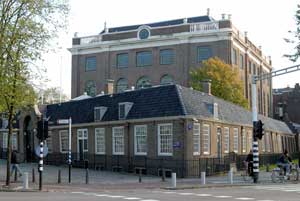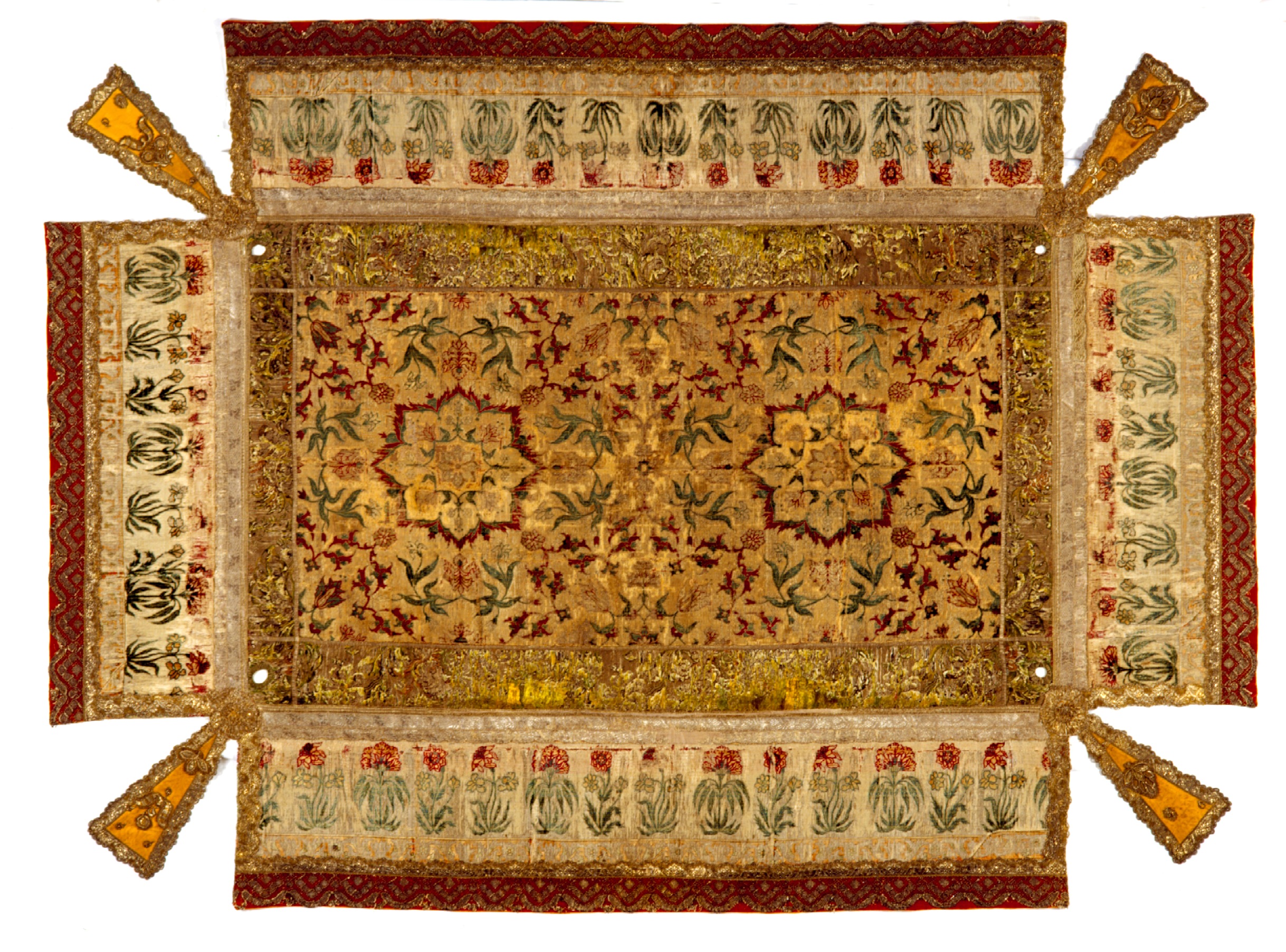In the 17th century, the Portuguese Synagogue was the largest synagogue in the world.
Location
Portugese Synagoge
Meester Visserplein 3
Type
Synagogue
Religious community
Portuguese Israelite Community Amsterdam
Object
Festive album with sermons and coloured engravings
Maker and date
David de Castro Tartas
1675
Visit
The festive album is not on display in the synagogue
Thriving Jewish communities emerged in Spain and Portugal as early as the early Middle Ages. From 711, the Iberian Peninsula was under Islamic rule in which Jews participated in society as an equal population group. These Spanish and Portuguese Jews are also called Sephardic Jews, after the Hebrew word for Spain, Sepharad. At the end of the 15th century, this period came to a brutal end with the expulsion of the Ottomans by Christian rulers. Other religions are no longer tolerated and persecuted. The Inquisition expels and murders Jews or forces them to convert to Christianity. Spanish and Portuguese Jews flee en masse, including to the Republic of the Netherlands.
The first Sephardic Jews settled in Amsterdam from 1600 onwards. The community holds services in small home synagogues. Three separate Sephardi communities merged in 1639 to form the Kahal Kadosh Talmud Tora, or the Portuguese-Israelite Congregation. As the Sephardic community grew rapidly, the board decided to have a large, majestic synagogue built in 1670.
Sephardic Jews
Hebr. Sephardim. Jews originating from Portugal, Spain, North Africa.
The festive dedication of the Portuguese Synagogue took place on 2 August 1675. This booklet contains the sermons delivered during the dedication by chacham Isaac Aboab da Fonseca, chacham Solomon de Oliveira and chacham Isaac Saruco, among others. The inclusion of detailed engravings of the interior and several plans of the new synagogue, made by engraver Romeyn de Hooghe (1645-1708), makes it a valuable memento. The booklet also lists the costs of construction and patrons. Architect and master builder Elias Bouman (1636-1686) makes the final design for the synagogue.
The Portuguese Synagogue consists of a main building surrounded by outbuildings for offices, a room for washing and caring for the deceased, a mikve (ritual bath), meeting room for the parnassim (committee members of the congregation), a smaller synagogue room for use at small services and during the winter period, and the seminary Talmud Tora with its associated library, now Library Ets Haim - Livraria Montezinos.
Chacham
Chief rabbi of a Portuguese or Spanish Jewish community.
Mikve
Ritual bath or bathhouse.
During worship in the synagogue, people read from the Torah from a raised platform called the tevah. This unique cloth placed over the teba (also called a manta) is made of precious fabrics from India and decorated with floral motifs and medallions. It is likely that this rug was also used during the dedication of the Portuguese Synagogue. It is therefore called the dedication tevah.
Tevah
Raised platform in a (Sephardic) synagogue, where the Torah is read.
Torah
Means teaching or doctrine in Hebrew. The Torah consists of the first five books of Moses, called the Old Testament by Christians: Bereshit (Genesis), Shemot (Exodus), Wajikra (Leviticus), Bemidbar (Numbers) and Devarim (Deuteronomy).
Lisa de Goffau
Collection curator Jewish Cultural Quarter
Last edited
November 08, 2024
Sermoes, David de Castro Tartas, Amsterdam, 1675, with coloured engravings by Romeyn de Hooghe, 23.9 x 19.5 cm. Collection Ets Haim - Livraria Montezinos.
Interior and exterior: photography Jewish Museum.
Manta, tevahcover, maker unknown, Mogul (India), before 1675, linen, velvet, silk, metal thread and gold brocade, 158 x 226 cm. Collection Portuguese-Israelite Congregation Amsterdam.
Schrijver, E. en H. Warncke, 18 Highlights from Ets Haim: The Oldest Jewish Library in the World, (Zutphen, Amsterdam 2016).
Vlaardingerbroek, P. ed., De Portugese Synagoge in Amsterdam (Amersfoort, Amsterdam, Zutphen 2013).









